A Few Minutes on Tailoring, Tibi & The Met Gala
A few words on Met Gala 2025, a Q&A with Tibi stylist & fellow DMV girl Fana Haile, who reminds us that the creative pragmatist mindset is about doing what feels good to you. And of course articles.
Happy Sunday to my lovely subscribers, and happy Mother’s Day to your moms, mother figures, aunties, baby mommas, expecting mothers, and those who’ve lost a mom, grandma, or child. Every emotion is valid on this day.
The 2025 Met Gala is behind us where the theme was Superfine: Tailoring Black Style, which explored Black dandyism and the role of sartorial style in forming Black identities. The dress code was Tailored for You," where some followed, and some failed to embrace tailored looks and menswear. I like to think my mom’s hat in the Instagram post below has a little dandy flair.
“Covered” is generous, but since about 2018, I’ve taken to my IG stories to share my thoughts, not informed by much but a Vogue subscription. This year, I had the joy of reading Monica Miller’s Slaves to Fashion: Black Dandyism and the Styling of Black Diasporic Identity. One of my favorite tidbits from the text is how Monica asserts that dandyism is inherently queer and introduces us to “quare”— a riff on "queer," is about embodying queerness through a distinctly Black lens. Miller cites E. Patrick Johnson, who defines quare as someone “odd and slightly off-kilter,” rooted in Black community, culture, and resistance—someone for whom race, gender, and sexuality are never separate.
Here’s a bit more on that from Miller’s text:
“In that dandies of any color disrupt and destabilize conceptions of masculinity and heterosexuality, they are queer subjects who deconstruct limiting binaries in the service of transforming how one conceives of identity formation. In that the black dandy adds a deconstruction of racial and ethnic ‘notions’ to this queerness, he might better be called ‘quare,’ or queer with a distinctly black accent. Using an African American vernacular for ‘queer,’ E. Patrick Johnson defines ‘quare’ as ‘odd and slightly off kilter,’ a ‘lesbian, gay, bisexual, or transgendered person of color who loves other men or women, sexually and / or nonsexually, and appreciates black culture and community,’ ‘one who thinks and feels and acts (and sometimes ‘acts up’); [who is] committed to struggle against all forms of oppression—racial, sexual, gender, class, religious, etc.,’ and, finally, “one for whom sexual and gender identities always already intersect with racial subjectivity.’ For Johnson, quare is queerness with some ‘shade’ thrown on it, a queerness that attends to the politics and performativity of identity without reifying debilitating notions of any of identity’s markers. As queer or quare performative beings, black dandies are creatures of invention who continually and characteristically break down limiting identity markers and propose new, more fluid categories within which to constitute themselves.”
You can head to my Instagram highlights to hear hot takes on the carpet. But when thinking about this concept of quare, it felt like that’s what last Monday’s carpet was missing—not in the identity of the attendees, but in the actual outfits. The interpretation of menswear felt one-note. I wanted more Prince, Zapp & Roger, Rick James, George Clinton, Bootsy Collins. And respectfully, Sofia Richie’s tailoring was immaculate, but how sweet if she’d paid homage to her own father’s sartorial legacy?
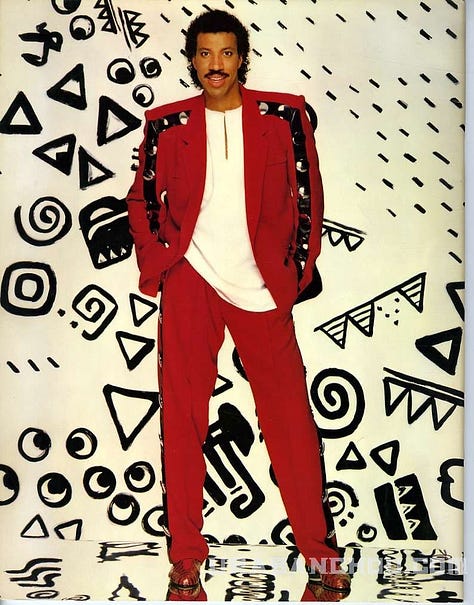
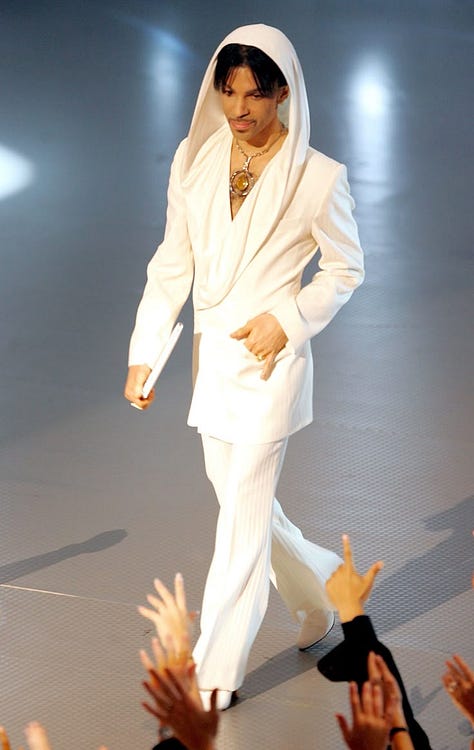
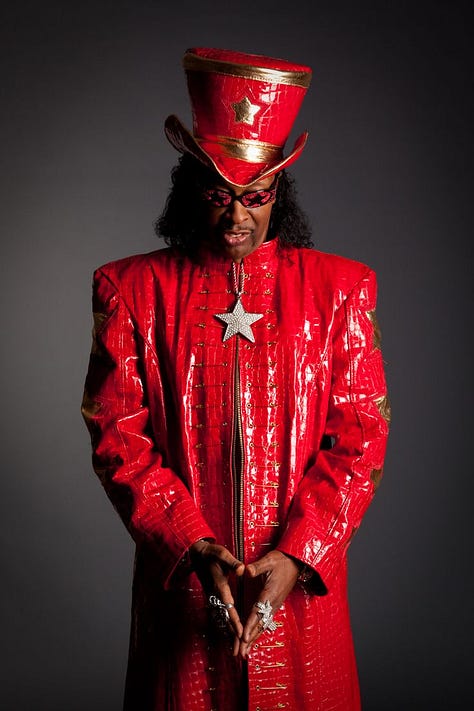
There were a lot of walking billboards at the Met this year. I didn’t love Damson Idris’ movie promo stunt or the LV branding on Doechii’s face—it felt tone-deaf for an event that, at its core, is honoring Black fashion history and scholarship.
Dandyism is equally rooted in resistance and respectability politics, or at least subverting our ideas of it. I instantly think of Dapper Dan’s Sankofa suit, Teyana Taylor’s durag moment styled by Ruth E. Carter, Jeremy Pope’s AW’97 Margiela bodice, Willy Chavarria’s zoot suits for himself and Maluma; all among the standouts of the night. I must mention André 3000, Zendaya, inspired by Diana Ross in Mahogany, Hunter Schafer, Walton Goggins, and Regina King in Who Decides War. Oh! And my mouth dropped when I saw Lauryn Hill arrive on time and Stevie Wonder walk the carpet.
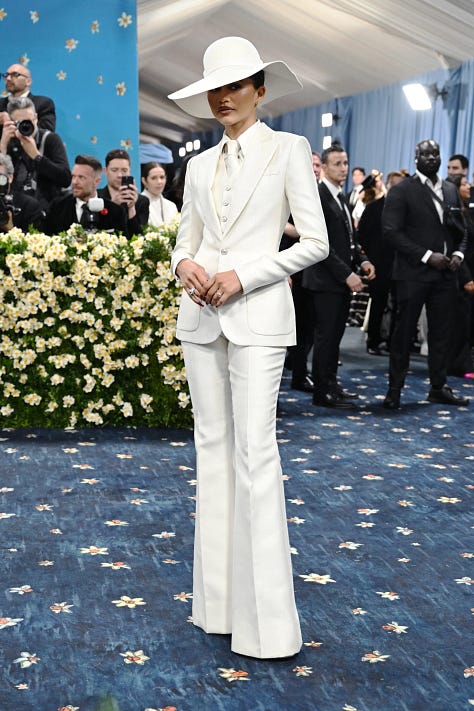
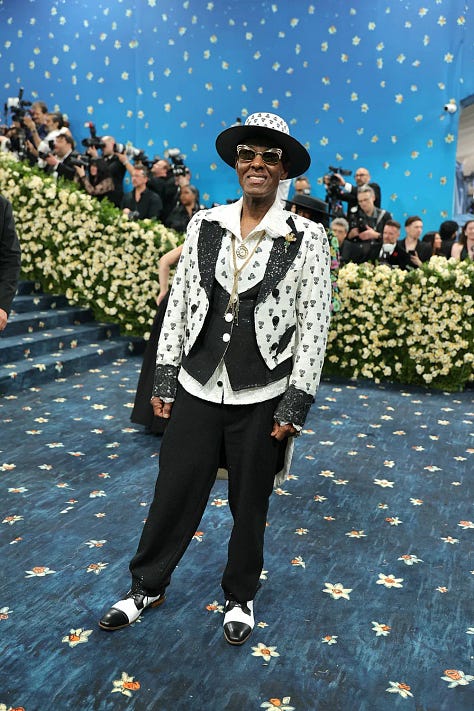
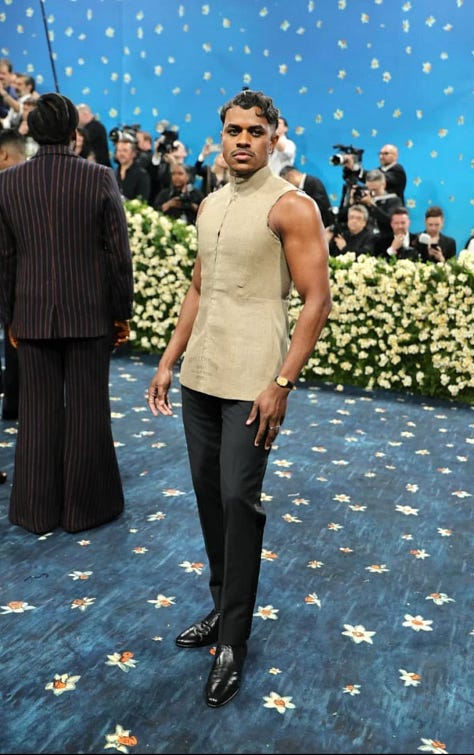
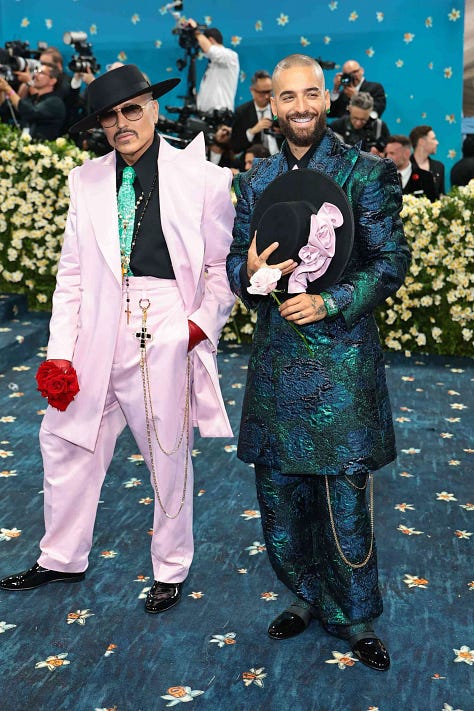
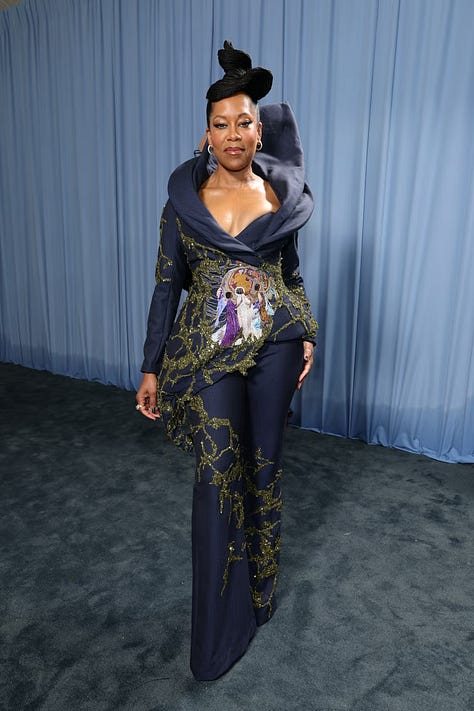
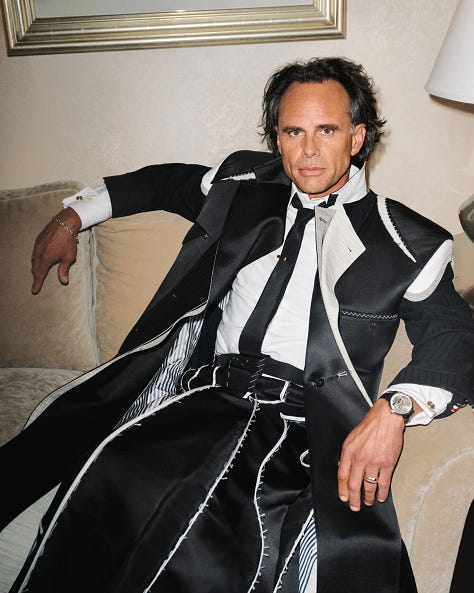
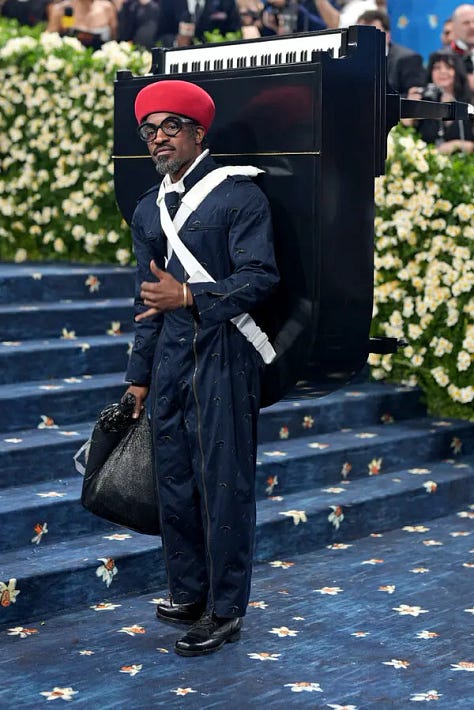
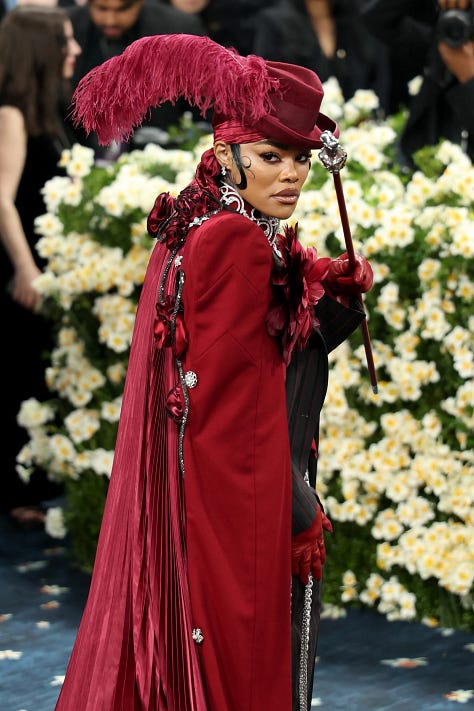
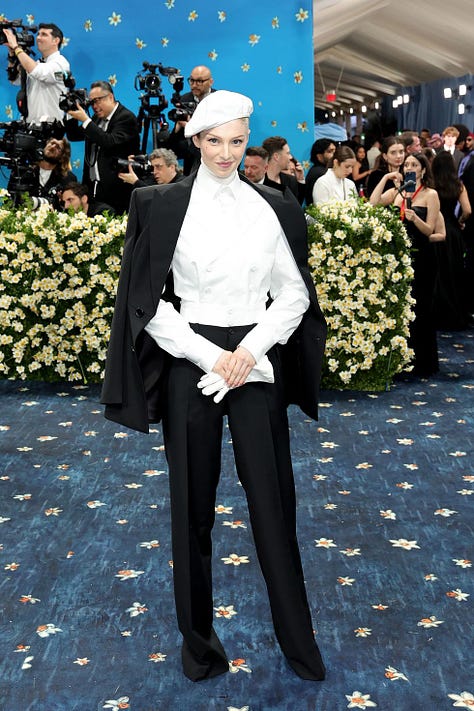
Shifting from the carpet to the closet: this month’s Q&A is with Fana Haile, a fellow DMV girl and stylist who’s worked with Dior, Barneys, The RealReal, and more. I don’t even remember how we met—just two stylish internet mutuals
Last year, Fana invited me to a Tibi event at the Eaton Hotel in D.C., where founder Amy Smilovic spoke about her book The Creative Pragmatist. Since then, I’ve bought the book and become more tuned into Fana’s work, and I realized I’d been into the brand even before I knew her. I’ve always been obsessed with their shearling flip-flops—they combine the coziness of Uggs with the kind of chic you’d expect from one of the models in the opening scene of The Devil Wears Prada. And honestly, that’s how I see Fana.
When we finally met in person at that Tibi event, hearing her and Amy talk about bringing structure and clarity to your wardrobe, especially for moms and working women, really stuck with me. A lot of the women in the crowd were asking how to make style feel both functional and personal, and that conversation felt so grounded and useful, even as someone who isn’t navigating those roles myself. Side note, we need more speaker series hosted by brands, please. Since then, the book has kept showing up in my life. I’m slowly building a uniform, trying on clothes more intentionally, and even thinking about Tibi’s infamous color wheel, especially since one of my goals for 27, just a month away, is to wear more color
Anyway, back to this month’s Q&A. We talked about the Tibi pieces you can pull from if you‘re obsessed with this year’s Met Gala theme, the power of getting dressed (something I wrote about in tribute to my dad in an earlier newsletter edition), Fana’s styling background, and more. If you have follow-up questions, drop them in the comments—I’ll circle back!
Are there any pieces in Tibi’s current inventory that speak to this year’s Met Gala theme, which focuses on sharp tailoring, dandyism, and quiet drama? Absolutely. Our designs are rooted in menswear, so we show at least 2 or 3 suits per season. Currently, my favorites are the Cavalier suit and our summer drapey suiting. We also have pieces like “the perfect men’s t-shirt” or our Gabe and Charlie button-ups. Some closet staples for sure.
Tibi founder, Amy Smilovic, coined the term “creative pragmatist,” where creativity meets utility to help people feel like their best selves. What does that concept mean to you?
It means being true to yourself without compromising. In fashion, there are certain tropes like “the little black dress” or a “power suit.” The creative pragmatist mindset is about doing what feels good to you. One’s version of a power suit could be an active knit sweat suit, or that “little black dress” could be a Black version of a pair of Sid jeans and a bustier. The creative pragmatist is a great guide to not only helping you get dressed, but it’s truly a mindset shift.
Okay, let’s be a little messy. What does it mean when “the clothes wear you? When someone buys something super hyped up or garners attention, without thinking about how it works for them. It could also read as someone isn’t confident in what they are wearing. You can always tell when a person isn’t comfortable in what they are wearing. They tend to be slightly closed off in their body language or scrunched up.
What shifts are you noticing in how customers are thinking about clothing?
Clients are more informed than ever before, especially with dupe culture. People are more conscious than ever. They want to know where garments are made, whether they were ethically produced, etc. Customers want to ensure their dollar is going the distance when approaching style and clothes.
Also, a lot of times when people don’t understand something, they usually put it down or mark it as frivolous. Fashion is no exception. I believe now, with more discourse on fashion, variety, and tools to help guide your style, it takes away the abstract portion of getting dressed and buying clothes.
Something we share is the loss of our fathers. Last fall, I wrote about the Met Gala, Black dandyism, and how I saw those elements in my dad’s wardrobe. What did you learn from your father about presentation and getting dressed? Are there pieces or style cues from him that still influence you?
My father’s parents died when he was really young. He became the man of the house quickly. He started working when they passed and had his own farming business by age 11. He worked his way up, and eventually, when he had disposable income, he started buying custom suits in Addis.
When he immigrated to D.C. on a student visa, nothing changed. He bought the most beautiful suits and thrifted a lot, which, in Ethiopian culture, is a big no-no, haha. I know that for him, getting dressed was an art. I remember he would take his time grooming and meticulously getting ready whenever he and my mother went out.
Amy and I did a talk last year called “Merging Your Mindset with Your Visuals.” For my father, I believe he genuinely loved getting dressed—but perhaps, subconsciously, it was also about survival and assimilation.
I learned what it meant to have personal style—and that less is more. Throughout my father’s life, he wore a rotation of Levi’s denim with a Lacoste polo, a baseball cap, or a full suit, no in between. He loved a good thrift find, which I still carry today. He also stressed the importance of buying less and buying intentionally. He was the first person I knew who talked about capsule wardrobes before it was even a thing.
Talk to me about working at Barneys, a place fashion girls of the mid-2010s still revere.
Barneys is where I refined a lot of my style. It was the mecca for all the fashion girls and boys. We had the best of everything you could think of. Our buy was well thought out, and we were at the forefront of many culturally significant fashion moments. I worked at Barneys when Hood By Air launched, Virgil was building Off-White, and Kanye was debuting his main runway line.
Barneys was a place you could just come and observe. If you couldn’t buy the $1,200 Margiela jacket, at least you could touch it. With the designer e-comm bubble declining, I hope we see more places like Barneys in the future.
Do you think we’ll ever see another retailer rise to that level of cultural significance? Is SSENSE the modern-day equivalent, or something else entirely?
SSENSE is doing a fantastic job with their marketing and social media, but Barney’s was the last of its kind. What made Barney’s so special was that it was a physical location with real people there every day who had to get dressed every day and be client-facing. That is one of the most important aspects of client relationships.
Tibi feels like it’s having a cultural moment, especially as conversations about personal style become more mainstream. What do you think the modern femme customer is really looking for right now?
The modern femme is looking for ease. She has so much going on—in work, in her personal life, and beyond. She wants the comfort of knowing: Okay, I don’t feel like thinking too hard about what to wear… but I still want to look great for this big meeting. What am I going to put on?
At Tibi, I have to say that out of all the brands and designers I’ve worked with, Tibi is truly an outlier. Our pieces are building blocks (WOFs—Without Fail pieces) that seamlessly integrate into your wardrobe and give you that ease in your closet. Then you have our mainline, which is a bit more experimental but equally impactful.
We make it really easy to get dressed.
Now, the Met Gala-related reads
If you want to go deeper, here are a few articles that expand on this year’s Met Gala theme, Black dandyism, and the politics of presentation.
“He dressed the way he wrote: with rhythm and always in response to what the world refused to see.” - On James Baldwin, the Black intellectual and dandyism for Vogue by Achille Tenkiang.
For Ebony Mag, Shelton Boyd Griffith takes us down memory lane through the pages of Ebony and JET magazines, which have long documented the Black dandy through celebrity, pedestrian, and commercial lenses.
A short but layered piece, yet a fun read on the parallels between Sammy Davis Jr. and Jeremy O'Harris, set against the backdrop of the 2025 Met Gala's dress code, “Tailored for You,” which is a nod to the exhibition “Superfine: Tailoring Black Style.” The article explores the intersection of race, class, and gender in Black men's style through the lens of Black dandyism. The piece also highlights how the growing presence / lyrical use of “him” in rap has evolved from a mere pronoun to a powerful statement, reflecting the affirmation of Black men’s greatness and its ties to dandyism. I hadn’t thought about it before, but reading that piece made me think: where was Gunna? He wears leather so well. Would’ve loved to see how someone like Valentino (who dressed Colman Domingo) or Chrome Hearts (guilty for Kim Kardashian’s look) might’ve interpreted that on him
For DAZED, what dandyism means to 12 Black creatives.
Complex’s PLEASE EXPLAIN episode on the Black Dandy is a must-watch. What I appreciate about this series—this episode especially—is how it centers actual experts, not just the famous. A couple of months ago, a clip from the interview went viral where Dapper Dan, June Ambrose, and Ali Richmond were asked whether Pharrell’s LV debut was inventive or boundary-breaking, and they pretty much scoffed at the idea. It sparked backlash, with some claiming that Black folks in fashion should always support one another. But when you consider June’s influence on the hip-hop imagination, Dapper Dan’s legacy as the father of logomania, and Richmond’s work expanding the range of Black identities in fashion, their skepticism holds real weight
What struck me rereading this 2020 interview is how relevant it still feels, especially as we continue to discuss Black creatives leading major fashion houses. I still question whether Pharrell at Louis Vuitton is truly impactful, or if it’s another example of “Black cool” being used as a surface-level symbol. Back in 2020, Ali Richmond said something in Coulture that stuck with me:
“We can’t just take certain Black images and put them on clothing because it’s about change from the inside. And with Virgil’s hire, the surrounding context is important because streetwear was becoming a big trend, Off-White was very successful, and the diversity and inclusion conversation [was] happening. So, Virgil’s a proven seller and he’s Black.
Now, I don’t know Kerby personally, but people say he’s difficult to work with. Is he really difficult—or does he just not go along to get along? It could be a combination of both, but there are so many white designers who are extremely difficult. With them, it’s ‘they’re geniuses.’”
One Last Note
I don’t know if my mind is doing some heavy lifting, but I’m not fully conscious of it. Fana feels like the perfect fit for this Met Gala–themed newsletter. Her outfits, her love of Jay-Z, and an oversized power suit that looks plucked straight out of The Wolf of Wall Street all give a bit of gender deviance in a world where everyone’s chasing Skims dupes and skinny-Tok is rampant.
The obsession with having a small waist, or needing to show it off, is ruining people’s ability to put together good outfits. A lot of female celebrities' interpretations of this year’s theme fell into that category. An outfit should complement your body, yes—but that doesn’t always mean highlighting your waist. If you shift your focus from showing your figure to exploring the possibilities of the garment itself, your sense of style will grow.
That’s what studying Fana’s style has made clear to me: when the body, a focus on abs, a cinched waist, or just looking “small” becomes the outfit, fashion becomes a performance of desirability rather than a practice of expression. “The body is the outfit” can hold truth; it reflects the tension between form and fabric, visibility and power, but too often, it becomes an excuse for sameness and is mostly fatphobic. A celebration of silhouette becomes a flattening of imagination.
Before I go, here are a few creators who are reimagining menswear silhouettes in ways that are intentional, not just trendy.


















Love your thoughts! I definitely agree and you can even read a master thread I made here:
https://threadreaderapp.com/thread/1919609296679014842.html
I can chat with you all day! Thank you Ellice xx